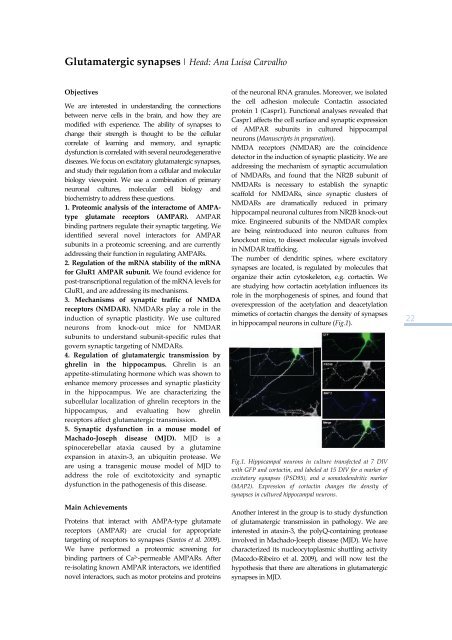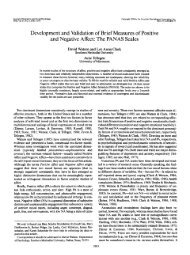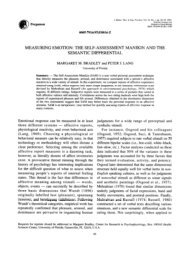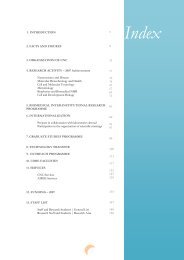Annual Report of Activities CNC 2008 - Center for Neuroscience and ...
Annual Report of Activities CNC 2008 - Center for Neuroscience and ...
Annual Report of Activities CNC 2008 - Center for Neuroscience and ...
You also want an ePaper? Increase the reach of your titles
YUMPU automatically turns print PDFs into web optimized ePapers that Google loves.
Glutamatergic synapses | Head: Ana Luisa CarvalhoObjectivesWe are interested in underst<strong>and</strong>ing the connectionsbetween nerve cells in the brain, <strong>and</strong> how they aremodified with experience. The ability <strong>of</strong> synapses tochange their strength is thought to be the cellularcorrelate <strong>of</strong> learning <strong>and</strong> memory, <strong>and</strong> synapticdysfunction is correlated with several neurodegenerativediseases. We focus on excitatory glutamatergic synapses,<strong>and</strong> study their regulation from a cellular <strong>and</strong> molecularbiology viewpoint. We use a combination <strong>of</strong> primaryneuronal cultures, molecular cell biology <strong>and</strong>biochemistry to address these questions.1. Proteomic analysis <strong>of</strong> the interactome <strong>of</strong> AMPAtypeglutamate receptors (AMPAR). AMPARbinding partners regulate their synaptic targeting. Weidentified several novel interactors <strong>for</strong> AMPARsubunits in a proteomic screening, <strong>and</strong> are currentlyaddressing their function in regulating AMPARs.2. Regulation <strong>of</strong> the mRNA stability <strong>of</strong> the mRNA<strong>for</strong> GluR1 AMPAR subunit. We found evidence <strong>for</strong>post‐transcriptional regulation <strong>of</strong> the mRNA levels <strong>for</strong>GluR1, <strong>and</strong> are addressing its mechanisms.3. Mechanisms <strong>of</strong> synaptic traffic <strong>of</strong> NMDAreceptors (NMDAR). NMDARs play a role in theinduction <strong>of</strong> synaptic plasticity. We use culturedneurons from knock‐out mice <strong>for</strong> NMDARsubunits to underst<strong>and</strong> subunit‐specific rules thatgovern synaptic targeting <strong>of</strong> NMDARs.4. Regulation <strong>of</strong> glutamatergic transmission byghrelin in the hippocampus. Ghrelin is anappetite‐stimulating hormone which was shown toenhance memory processes <strong>and</strong> synaptic plasticityin the hippocampus. We are characterizing thesubcellular localization <strong>of</strong> ghrelin receptors in thehippocampus, <strong>and</strong> evaluating how ghrelinreceptors affect glutamatergic transmission.5. Synaptic dysfunction in a mouse model <strong>of</strong>Machado‐Joseph disease (MJD). MJD is aspinocerebellar ataxia caused by a glutamineexpansion in ataxin‐3, an ubiquitin protease. Weare using a transgenic mouse model <strong>of</strong> MJD toaddress the role <strong>of</strong> excitotoxicity <strong>and</strong> synapticdysfunction in the pathogenesis <strong>of</strong> this disease.Main AchievementsProteins that interact with AMPA‐type glutamatereceptors (AMPAR) are crucial <strong>for</strong> appropriatetargeting <strong>of</strong> receptors to synapses (Santos et al. 2009).We have per<strong>for</strong>med a proteomic screening <strong>for</strong>binding partners <strong>of</strong> Ca 2+ ‐permeable AMPARs. Afterre‐isolating known AMPAR interactors, we identifiednovel interactors, such as motor proteins <strong>and</strong> proteins<strong>of</strong> the neuronal RNA granules. Moreover, we isolatedthe cell adhesion molecule Contactin associatedprotein 1 (Caspr1). Functional analyses revealed thatCaspr1 affects the cell surface <strong>and</strong> synaptic expression<strong>of</strong> AMPAR subunits in cultured hippocampalneurons (Manuscripts in preparation).NMDA receptors (NMDAR) are the coincidencedetector in the induction <strong>of</strong> synaptic plasticity. We areaddressing the mechanism <strong>of</strong> synaptic accumulation<strong>of</strong> NMDARs, <strong>and</strong> found that the NR2B subunit <strong>of</strong>NMDARs is necessary to establish the synapticscaffold <strong>for</strong> NMDARs, since synaptic clusters <strong>of</strong>NMDARs are dramatically reduced in primaryhippocampal neuronal cultures from NR2B knock‐outmice. Engineered subunits <strong>of</strong> the NMDAR complexare being reintroduced into neuron cultures fromknockout mice, to dissect molecular signals involvedin NMDAR trafficking.The number <strong>of</strong> dendritic spines, where excitatorysynapses are located, is regulated by molecules thatorganize their actin cytoskeleton, e.g. cortactin. Weare studying how cortactin acetylation influences itsrole in the morphogenesis <strong>of</strong> spines, <strong>and</strong> found thatoverexpression <strong>of</strong> the acetylation <strong>and</strong> deacetylationmimetics <strong>of</strong> cortactin changes the density <strong>of</strong> synapsesin hippocampal neurons in culture (Fig.1).Fig.1. Hippocampal neurons in culture transfected at 7 DIVwith GFP <strong>and</strong> cortactin, <strong>and</strong> labeled at 15 DIV <strong>for</strong> a marker <strong>of</strong>excitatory synapses (PSD95), <strong>and</strong> a somatodendritic marker(MAP2). Expression <strong>of</strong> cortactin changes the density <strong>of</strong>synapses in cultured hippocampal neurons.Another interest in the group is to study dysfunction<strong>of</strong> glutamatergic transmission in pathology. We areinterested in ataxin‐3, the polyQ‐containing proteaseinvolved in Machado‐Joseph disease (MJD). We havecharacterized its nucleocytoplasmic shuttling activity(Macedo‐Ribeiro et al. 2009), <strong>and</strong> will now test thehypothesis that there are alterations in glutamatergicsynapses in MJD.22






